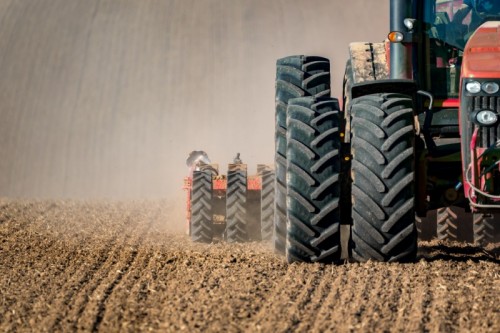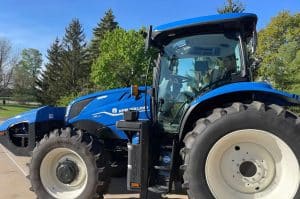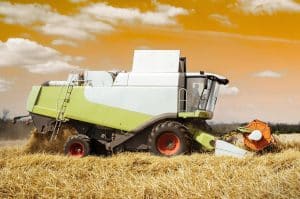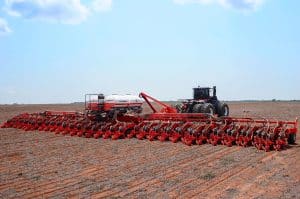The US Association of Equipment Manufacturers (AEM), in partnership with the American Soybean Association, CropLife America, and National Corn Growers Association, released a study quantifying how widely available precision agriculture technology improves environmental stewardship while providing economic return for farmers.
“All indications are that the farm economy is going to continue to be strong into 2021 and perhaps for years to come,” says Curt Blades, Senior VP of Ag Services for AEM. “So the ag equipment sales numbers typically go hand-in-glove with the ag economy.”
But could that strength in ag equipment sales also lead to a similar boom in sustainable, more environmentally friendly agriculture overall?
“One of the things that we certainly find is fuel efficiency does become a deciding factor. And when we’re talking about recent spikes in fuel costs, in diesel costs, that makes a real difference,” says Blades. “If you’ve got a tractor engine or a combine engine that is 20 percent more efficient than the previous model, that’s real dollars at the end of the day when you consider how long those are driven.”
The reduction in fuel costs isn’t the only benefit, however.
The environmental benefits of precision Ag
According to the study on precision agriculture, the environmental benefit of precision agriculture technology fuel efficiencies is similar to taking 200,000 cars off the road every year. But reducing fuel use isn’t everything.
“The pieces of equipment that farmers, that we’re hearing, are most excited about is anything that has to do with variable rate technology,” Blades explains. “Variable rate meaning adjusting the seed, adjusting the application of crop protection chemicals, or anything that can be done at the sub-field level to really take advantage of that technology. Those are the pieces of technology that farmers are pining for and, certainly, making their investments in right now.”
It’s that variable-rate technology that is what many commonly think of when thinking of “smart” technology. What the technology allows a farmer to do is adjust everything from how deep a seed is planted, to how much fertilizer or other chemicals are applied, in some cases, to a nearly plant-by-plant basis.
Equipment manufacturers have already reduced pesticide applications by 30 million pounds per year. This has been accomplished through combining variable rate technology with auto-guidance technology, which allows machines to drive themselves and go precisely where they need to down to the inch, and section-control technologies, which prevent planters, spreaders and sprayers from wasting seed and chemicals on spots where they’ve already been applied.
That’s the equivalent of more than four Saturn V rockets.
And the increased yields from these technologies have saved the U.S. from needing to cultivate more than 10 million additional acres. That’s equivalent to the land area of the Commonwealth of Massachusetts…twice.
Where farmers and the environment agree
Plus, the more that farmers are able to invest in new equipment, the faster the economic and environmental savings add up.
“Part of the story of new purchases of equipment have to do with the age of the equipment that it’s replacing. Some of it has to do with taking advantage of financing situations or economic situations,” Blades says. “But absolutely part of that story is farmers wanting to take advantage of new technology. New technology in planting, new technology in harvesting, and new technologies in tractors in general are absolutely part of the story and that is driving a whole lot of sales right now. “
The biggest opportunity with the most immediate need right now, however, may be in precision irrigation control.

Curt Blades: “For precision agriculture to really live up to its full potential, it needs to be able to access the internet on a real-time basis”
The Western United States is currently facing the worst drought it has experienced in more than a millennium according to the U.S. Drought Monitor.
Already, the combination of variable rate precision irrigation technology and soil moisture sensors is saving the equivalent of 750,000 Olympic-sized swimming pools of irrigation water per year, according to the industry study.
However, with full adoption, the U.S. could increase water savings an additional 21 percent, or nearly the equivalent of Cayuga Lake, the second largest of the Finger Lakes in Upstate New York.
Tech needs to talk
But to get there, the U.S. need additional bandwidth.
“One of the issues that has dramatically affected the adoption of precision agriculture, and certainly precision agriculture living up to its full potential, is the availability of rural broadband,” Blades explains. “In many areas of the nation today, as we’ve pointed out over the last year, they simply do not have access to reliable high-speed internet. That is especially pronounced in rural areas. So for precision agriculture to really live up to its full potential, it needs to be able to access the internet on a real-time basis.”
The current farm equipment sales boom looks like it could be the sort of help the environment needs to keep feeding everyone sustainably, especially as the age of the ag equipment fleet had been rising steadily over the past several years due to uncertainty in the ag market.
“We have been seeing the average age of equipment kind of creep up there just a little bit,” Blades says about the motivation behind the data. “Some of that has to do with, over the last five years, we’ve had some uncertainty in the ag economy in general, so most of the tractor sales that have been happening have been happening as a result of the replacement market.”

![RightSpot Ad Template Digital-1400×190-px[76] Ag Leader RightSpot](https://world-agritech.com/wp-content/uploads/elementor/thumbs/RightSpot-Ad-Template-Digital-1400x190-px76-r316mmc0hgoob9qxmklllnnbxta1nlj7t2vjkoyeek.png)







